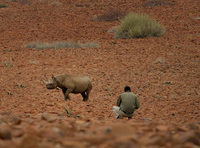A conservation success story in Namibia

Conservancy Safaris Namibia will be helping to make history this week as up to 15 black rhino are released into the 13,500 sq km Kunene region of North West Namibia.
Be one of the first to see these magnificent mammals in the wild and support the conservation work with a Conservancy Safaris tour.
Namibia is home to the largest free roaming population of black rhino in the world. The newest additions are being released into the Puros and Orumpembe conservancies of Kunene starting on 17 July 2010, in collaboration with WWF. The 12 to 15 black rhino are being translocated from the Palmwag region of the country, a welcome wildlife boost giving further confirmation of the success of community based natural resource management in this remote North West corner of Namibia, communal land with no formal conservation status.
Conservancy Safaris’ tours offer in-depth excursions into this vast, arid land, giving guests an insider’s view of community-based conservation in action. With 100% of the ownership of Conservancy Safaris Namibia vested in the Himba and Herero people, there is a real incentive for local communities to protect their natural heritage and stamp out poaching, one of the biggest threats to this endangered species.
The ‘Kunene Kaleidoscope’ is a 10 day tour, providing the ultimate wildlife, conservation and indigenous culture experience. The tour starts from Swakopmund and costs from US$5,950 (around £3,950) per person, excluding international flights.
Black rhino facts:
• The desert-adapted black rhino present in the Kunene Region represent the only rhino worldwide that have survived on communal land, outside of a national reserve.
• It is the only desert-specific population of black rhino in the world.
• The desert-adapted black rhino population is currently one of very few populations in Africa that is steadily increasing. Numbers have more than doubled in recent years, from fewer than 60 in the early 80s to 146 as of the 2006 census.
• The word “black” was probably chosen to distinguish it from the white rhinoceros. Neither species is distinguishable by colour. The white rhino got its name from the Afrikaans word for wide (“wyd”) referring to its upper lip. Early English explorers thought this was “white” and consequently named the other rhino “black” as it was different.
• The black rhino is also called the “hook-lipped” rhino because of its prehensile upper lip, which it uses to browse and feed on twigs.
• Black rhinos browse for food in the morning and evening and sleep or wallow during the hottest part of the day.
• Black rhinos weigh around 1 tonne (800 – 1500 kg) but, despite their weight, can run at speeds of up to 65 km per hour.
For further information, visit: kcs-namibia.com.na

